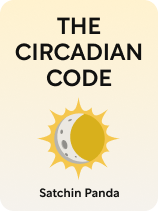

This article is an excerpt from the Shortform book guide to "The Circadian Code" by Satchin Panda. Shortform has the world's best summaries and analyses of books you should be reading.
Like this article? Sign up for a free trial here.
Are you struggling with sleep or feeling low on energy during the day? How does light exposure affect your body’s natural rhythms?
Your circadian rhythm and light exposure are closely linked, influencing everything from sleep quality to mood and productivity. In The Circadian Code, Satchin Panda argues that understanding this connection can help you make simple changes to improve your overall well-being and daily performance.
Continue reading to discover how to harness the power of light for better health.
Circadian Rhythm and Light Exposure
Panda contends that you should align your circadian rhythm and light exposure. He explains that light serves as an important cue for your circadian rhythm, helping it stay in sync with the outside world.
(Shortform note: Environmental cues that help synchronize your circadian rhythm with the outside world are known as zeitgebers (German for “time givers”). While light exposure is the most powerful zeitgeber, other factors such as meal timing, physical activity, social interactions (like going to school or work), and even temperature changes all play a role in synchronizing your circadian rhythm.)
Panda explains that your body senses light through a protein in your eyes called melanopsin, which is different from the rod and cone cells that allow you to see. Even people who are blind or visually impaired feel the effects of light due to melanopsin. When light activates these proteins, your body recognizes that it’s daytime and prepares for waking activities like working and eating. When there’s no light, melanopsin remains unactivated, so your body concludes that it’s nighttime and prepares for sleep.
(Shortform note: Melanopsin is found in special cells called intrinsically photosensitive retinal ganglion cells (ipRGCs). These cells are responsible for non-image visual functions, which means they respond to light but don’t contribute to what you actually see. IpRGCs start working much earlier in life than rods and cones. In fact, they’re the only light-sensing cells that function in newborn mammals for about the first 10 days of life. However, although melanopsin may allow people who are blind or visually impaired to sense light, many of these individuals still suffer from health problems relating to circadian rhythm disruption, such as mood and sleep disorders.)
If you’re surrounded by artificial light (like most people), you may be activating melanopsin at the wrong times and disrupting your circadian rhythm. Bright lights at night trick your brain into thinking it’s daytime, making it harder to fall asleep and get quality rest. Additionally, if you stay indoors for most of the day, you aren’t getting enough light to trigger your melanopsin, leaving you feeling unenergized. Over time, this improper light exposure can lead to mental health issues like depression and anxiety.
(Shortform note: Not getting enough natural sunlight during the day not only affects your energy levels and mental health, but it can also lead to other health issues. In The Nature Fix, Florence Williams explains that when you don’t get enough sun exposure, your body can’t produce enough vitamin D, which is essential for strong bones. In fact, this has caused a resurgence of a bone disease called rickets in children living in some areas of the UK. Furthermore, a lack of sunlight may worsen your vision. Your eyes need natural light to develop properly, especially when you’re young. Spending most of your time indoors, especially staring at digital screens, can increase your risk of developing myopia or nearsightedness.)
To improve your health, give your body the right amount of light at the right time. Panda provides two tips for syncing your light exposure to your circadian rhythm: avoiding blue light at night and getting plenty of bright light during the day.
Habit #1: Avoid Blue Light at Night
First, Panda suggests you reduce your blue light exposure at night to avoid confusing your circadian rhythm. He explains that your body reacts differently depending on the color of light. Blue light activates melanopsin and makes your brain think that it’s daytime, causing it to reset your internal clock to morning. Red or orange light, however, has less of an impact on melanopsin, allowing your brain to still think that it’s nighttime.
(Shortform note: Some research suggests that our heightened sensitivity to blue light stems from our evolutionary history. When life first emerged in the oceans, blue wavelengths of light penetrated the water more easily than other colors. As a result, organisms evolved photoreceptors that were particularly responsive to blue wavelengths. It’s believed that this adaptation persisted throughout evolutionary history, even as life moved onto land, because the sky’s blue color reinforced the importance of blue light as a signal for daytime.)
Exposure to blue light at night suppresses melatonin production and harms your sleep quality. For this reason, Panda recommends you avoid screens before going to bed. Consider wearing blue-light-blocking glasses in the evening and using blue-light filters on your phones and other devices. You can even set up adjustable LED lights in your home that can shift to warmer tones in the evening.
(Shortform note: Consider implementing a digital sunset routine, where you gradually reduce your exposure to screens and artificial light sources in the hours leading up to bedtime. This can include dimming household lights, using candlelight or salt lamps for ambient lighting, and engaging in relaxing, screen-free activities like reading physical books, journaling, or light stretching. Turning Panda’s blue light reduction strategies into a routine can help you get better sleep with less effort.)
Habit #2: Get a Lot of Bright Light During the Day
In addition to avoiding blue light at night, Panda encourages you to improve your circadian health by getting an abundance of light during the day. Exposing yourself to bright light as soon as you wake signals to your body that it’s daytime. Let in natural sunlight or take a short walk outside if you can.
Panda writes that being in bright light, especially sunlight, makes a big difference in how you feel and work. More exposure to natural light can make you happier, more alert, and perform better. While indoor lighting (even from the brightest LED bulbs) can’t fully replicate the benefits of sunlight, being in a well-lit indoor area can still mimic some of the positive effects of outdoor light exposure.
(Shortform note: Light therapy lamps can be a valuable alternative when natural sunlight isn’t available. These lamps simulate natural sunlight and can be especially helpful during darker winter months or for those who work in windowless environments. Some experts recommend you look for one that provides 10,000 lux of light and filters out UV rays to protect your eyes. Position the lamp 16 to 24 inches from your face and use it for about 20 to 30 minutes each morning.)
Exercise
How much natural light exposure do you get during the day? What are some ways you might increase your daytime light exposure, such as taking a morning walk or working near a window?

———End of Preview———
Like what you just read? Read the rest of the world's best book summary and analysis of Satchin Panda's "The Circadian Code" at Shortform.
Here's what you'll find in our full The Circadian Code summary:
- The modern habits that disrupt your circadian rhythm
- How your internal 24-hour schedule works
- The little habits that will recharge your battery






